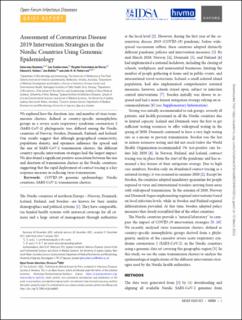Assessment of Coronavirus Disease 2019 Intervention Strategies in the Nordic Countries Using Genomic Epidemiology
| dc.contributor.author | Duchene, Sebastian | |
| dc.contributor.author | Featherstone, Leo | |
| dc.contributor.author | de Blasio, Birgitte Freiesleben | |
| dc.contributor.author | Holmes, Edward C. | |
| dc.contributor.author | Bohlin, Jon | |
| dc.contributor.author | Pettersson, John H.-O. | |
| dc.date.accessioned | 2022-03-16T07:36:15Z | |
| dc.date.available | 2022-03-16T07:36:15Z | |
| dc.date.created | 2022-03-15T11:27:26Z | |
| dc.date.issued | 2022 | |
| dc.identifier.citation | Open Forum Infectious Diseases. 2022, 9 (3), 1-6. | |
| dc.identifier.issn | 2328-8957 | |
| dc.identifier.uri | https://hdl.handle.net/11250/2985367 | |
| dc.description.abstract | We explored how the duration, size, and number of virus transmission clusters, defined as country-specific monophyletic groups in a severe acute respiratory syndrome coronavirus 2 (SARS-CoV-2) phylogenetic tree, differed among the Nordic countries of Norway, Sweden, Denmark, Finland, and Iceland. Our results suggest that although geographical connectivity, population density, and openness influence the spread and the size of SARS-CoV-2 transmission clusters, the different country-specific intervention strategies had the largest impact. We also found a significant positive association between the size and duration of transmission clusters in the Nordic countries, suggesting that the rapid deployment of contact tracing is a key response measure in reducing virus transmission. | |
| dc.language.iso | eng | |
| dc.title | Assessment of Coronavirus Disease 2019 Intervention Strategies in the Nordic Countries Using Genomic Epidemiology | |
| dc.type | Peer reviewed | |
| dc.type | Journal article | |
| dc.description.version | publishedVersion | |
| dc.source.pagenumber | 1-6 | |
| dc.source.volume | 9 | |
| dc.source.journal | Open Forum Infectious Diseases | |
| dc.source.issue | 3 | |
| dc.identifier.doi | 10.1093/ofid/ofab665 | |
| dc.identifier.cristin | 2009907 | |
| cristin.ispublished | true | |
| cristin.fulltext | original | |
| cristin.qualitycode | 1 |
Tilhørende fil(er)
Denne innførselen finnes i følgende samling(er)
-
Artikler [5061]
-
Publikasjoner fra CRIStin FHI [7536]
